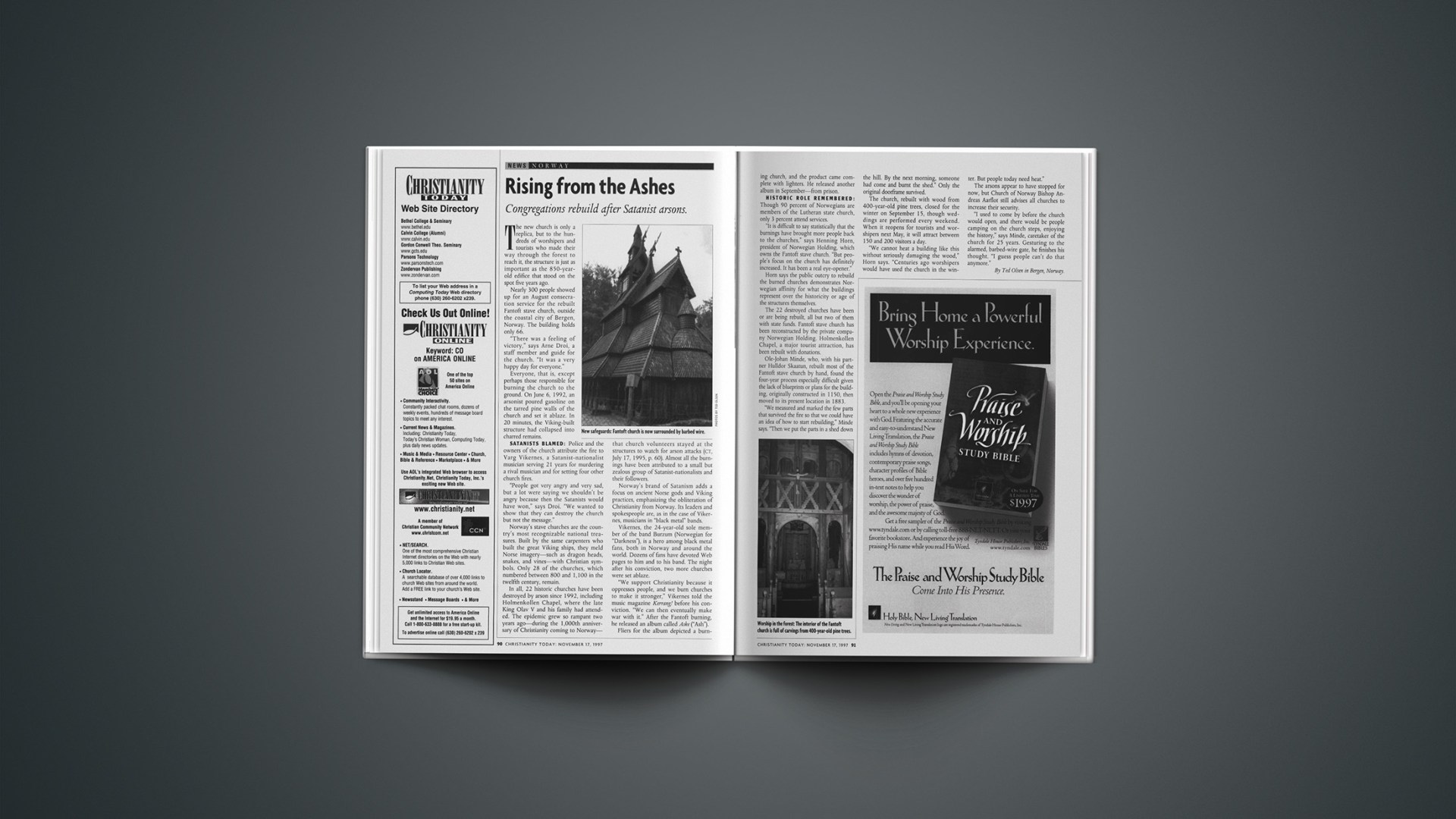The new church is only a replica, but to the hundreds of worshipers and tourists who made their way through the forest to reach it, the structure is just as important as the 850-year-old edifice that stood on the spot five years ago.
Nearly 300 people showed up for an August consecration service for the rebuilt Fantoft stave church, outside the coastal city of Bergen, Norway. The building holds only 66.
“There was a feeling of victory,” says Arne Droi, a staff member and guide for the church. “It was a very happy day for everyone.”
Everyone, that is, except perhaps those responsible for burning the church to the ground. On June 6, 1992, an arsonist poured gasoline on the tarred pine walls of the church and set it ablaze. In 20 minutes, the Viking-built structure had collapsed into charred remains.
SATANISTS BLAMED: Police and the owners of the church attribute the fire to Varg Vikernes, a Satanist-nationalist musician serving 21 years for murdering a rival musician and for setting four other church fires.
“People got very angry and very sad, but a lot were saying we shouldn’t be angry because then the Satanists would have won,” says Droi. “We wanted to show that they can destroy the church but not the message.”
Norway’s stave churches are the country’s most recognizable national treasures. Built by the same carpenters who built the great Viking ships, they meld Norse imagery—such as dragon heads, snakes, and vines—with Christian symbols. Only 28 of the churches, which numbered between 800 and 1,100 in the twelfth century, remain.
In all, 22 historic churches have been destroyed by arson since 1992, including Holmenkollen Chapel, where the late King Olav V and his family had attended. The epidemic grew so rampant two years ago—during the 1,000th anniversary of Christianity coming to Norway—that church volunteers stayed at the structures to watch for arson attacks (CT, July 17, 1995, p. 60). Almost all the burnings have been attributed to a small but zealous group of Satanist-nationalists and their followers.
Norway’s brand of Satanism adds a focus on ancient Norse gods and Viking practices, emphasizing the obliteration of Christianity from Norway. Its leaders and spokespeople are, as in the case of Vikernes, musicians in “black metal” bands.
Vikernes, the 24-year-old sole member of the band Burzum (Norwegian for “Darkness”), is a hero among black metal fans, both in Norway and around the world. Dozens of fans have devoted Web pages to him and to his band. The night after his conviction, two more churches were set ablaze.
“We support Christianity because it oppresses people, and we burn churches to make it stronger,” Vikernes told the music magazine Kerrang! before his conviction. “We can then eventually make war with it.” After the Fantoft burning, he released an album called Aske (“Ash”).
Fliers for the album depicted a burning church, and the product came complete with lighters. He released another album in September—from prison.
HISTORIC ROLE REMEMBERED: Though 90 percent of Norwegians are members of the Lutheran state church, only 3 percent attend services.
“It is difficult to say statistically that the burnings have brought more people back to the churches,” says Henning Horn, president of Norwegian Holding, which owns the Fantoft stave church. “But people’s focus on the church has definitely increased. It has been a real eye-opener.”
Horn says the public outcry to rebuild the burned churches demonstrates Norwegian affinity for what the buildings represent over the historicity or age of the structures themselves.
The 22 destroyed churches have been or are being rebuilt, all but two of them with state funds. Fantoft stave church has been reconstructed by the private company Norwegian Holding. Holmenkollen Chapel, a major tourist attraction, has been rebuilt with donations.
Ole-Johan Minde, who, with his partner Hulldor Skaatun, rebuilt most of the Fantoft stave church by hand, found the four-year process especially difficult given the lack of blueprints or plans for the building, originally constructed in 1150, then moved to its present location in 1883.
“We measured and marked the few parts that survived the fire so that we could have an idea of how to start rebuilding,” Minde says. “Then we put the parts in a shed down the hill. By the next morning, someone had come and burnt the shed.” Only the original doorframe survived.
The church, rebuilt with wood from 400-year-old pine trees, closed for the winter on September 15, though weddings are performed every weekend. When it reopens for tourists and worshipers next May, it will attract between 150 and 200 visitors a day.
“We cannot heat a building like this without seriously damaging the wood,” Horn says. “Centuries ago worshipers would have used the church in the winter. But people today need heat.”
The arsons appear to have stopped for now, but Church of Norway Bishop Andreas Aarflot still advises all churches to increase their security.
“I used to come by before the church would open, and there would be people camping on the church steps, enjoying the history,” says Minde, caretaker of the church for 25 years. Gesturing to the alarmed, barbed-wire gate, he finishes his thought. “I guess people can’t do that anymore.”
Copyright © 1997 Christianity Today. Click for reprint information.










